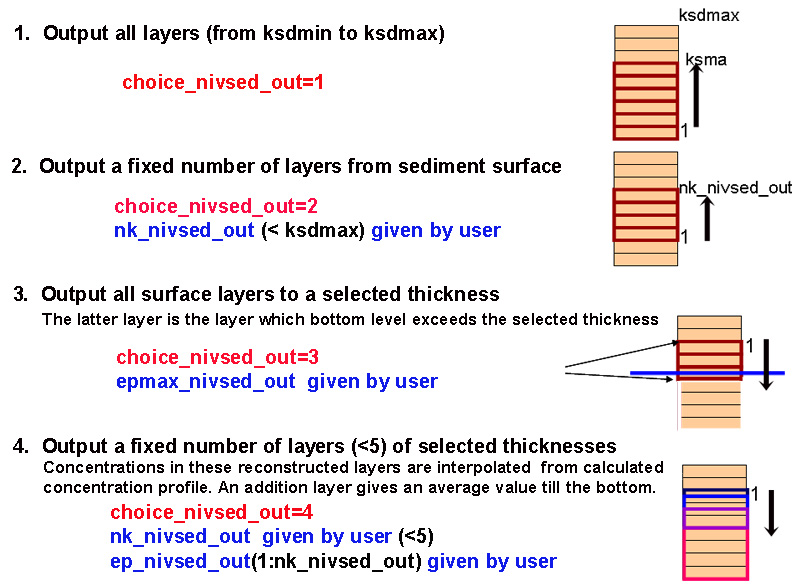namelist for sediment : parasedim.txt¶
- These namelists define sediment behaviour and manage sediment parameters.
- There are 2 namelist corresponding to the 2 options and 1 namelist for output
- the option sedim_mudsand is no longer maintained.
- Definition of each variable is given into the namelist file :
Namelist sedoutput :¶
variable Observations
Namelist namsedim : parameters for CPP key_sedim_mixsed only¶
variable Observations
Definition of parameters for particulate-sediment substances in variable.dat¶
- particulate variables are defined in variable.dat : Defined simulated substances as :
- GRAV or SAND or MUDS or PART : constitutive variables (kg/m3)
- SORB or NoCP : non constitutive variables (X/m3)
For GRAV and SAND variables, only diameter of particles, critical stress of deposition and density of particle are given in variable.dat
- For MUDS, PART and NoCP
: settling velocity varies with time and space (Settling velocities : Modelling strategy) and 4 lines with 11 parameters are given in variable.dat
- 1 option for free velocity followed by 6 parameters
: minimum and maximum setling velocity (m/s) and :
- If ws_free_opt=0 (Ws constant) ==>> (1)=unused (2)= unused (3)=unused (4)=unused
- If ws_free_opt=1 (Van Leussen) ==>> (1)=c_factor (2)=c_exponent (3)=VL_a (4)=VL_b
- If ws_free_opt=2 (Winterwerp) ==>> (1)= Primary Particle Diameter (2)=aggregation factor (3)=breakup factor (4)=fractal dimension
- If ws_free_opt=3 (Wolanski) ==>> (1)= c_factor (2)=c_exponent (3)=unused (4)=unused
- 1 option for hindered velocity followed by 2 parameters :
- If ws_hind_opt=0 (no hindered settling) ==> (1)=unused (2)=unused
- If ws_hind_opt=1 (Scott) ==> (1)=phi_factor (2)=phi_exponent
- If ws_hind_opt=2 and ws_free_opt=2 (Winterwerp) ==> (1)=gel concentration (kg/m3) (2)=phi_exponent
- If ws_hind_opt=3 (Wolanski) ==> (1)=c_constant (2)=c_exponent
- diameter of particles, critical stress of deposition and density of particle are given after
For SORB variables, user must given the name of the associated constitutive particulate variable.
- Inital concentration in sediment is expressed as :
- gravel, sand, mud and PART : fraction of total initial sediment concentration (total=1)
- SORB (or NCSP) : unit/m3 of sediment
- DISS : unit of m3 of interstitial water
- For SAND variable only; 2 boolean are given in variable.dat :
- l_sand2D which is TRUE if this sand variable is treated as 2D variable (used only if key_sand2D)
- l_outsandrouse which is TRUE if you want to use a ROUSE profil reconstituted for output in water column (used only if ikey_sand2D and l_sand2D is TRUE for this variable)
Special writing of sand in water column and of all variables in sediment (with key_sedim)¶
Output sand variables in water column (if key_sandbottomcell & key_sedim_mixsed)¶
- If key_sandbottomcell is activated, sand variables with l_sandbottom =. TRUE. (in variable.dat) can be written in two different ways
- either l_outsandrouse=.FALSE. (in parasedim.txt): only the average value in the water column, determined in 2D by the model, is written at k = 1
- either l_outsandrouse=.TRUE. : a profile over the entire water column is artificially reconstructed from the calculated average value according to a Rouse profile.
Output variables in sediment¶
- There are 4 different ways to write variables in sediment.

- User chooses the option with parameters listed in namelist namsedoutput (parasedim.txt)
- choice_nivsed_out : 1,2 3 or 4
- nk_nivsed_out : number of saved sediment layers
- ep_nivsed_out (mm) : 5 values of sediment layer thickness (mm), beginning with surface layer (choice 4). Last layer (6th) is an integrative layer.
- epmax_nivsed_out (mm) : maximum thickness (mm) for output each layers of sediment (choice 3). Below this thickness, output an integrative layer.
